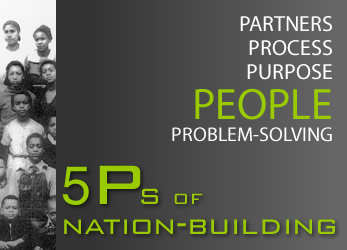Chapter 2 excerpt
U.S. South: Reconstruction after civil war


Click to learn more about the 5 "P"s of nation-building.
This chapter analyzes the nation-building efforts within the United States that followed in the aftermath of the Civil War and the defeat of the Confederacy. Nation-building was a project that brought many PEOPLE together for the first time, especially former slaves.
The 19th century was a century of nation-building on four
continents. It witnessed the emergence of united, independent Latin
American, Japanese, Italian, and German nations that would transform
international politics and domestic society—and precipitate two
world wars.
Before 1800 few people thought of themselves as part of
a coherent "Argentine," "Japanese," or "German" identity; after 1870
these national identities mobilized people across large centrally organized
territories. New unions of diverse "peoples" superseded traditional
local allegiances. The nation-state quickly became the common
architecture for modern politics.
The United States was a leader in this process. No other government
did more to remake the lives of citizens in a region, despite stubborn
local traditions to the contrary. No other government devoted as
much force, money, and policy innovation to the rapid formation of a
new society. No other government redistributed
property, power, and
political voice with such rapidity and reach.
"Second American Revolution"
Foreign observers studied
the American Civil War as the first modern war; they saw Southern
Reconstruction as the most ambitious, and perhaps foolhardy, effort
at modern nation-building. This was a "Second American Revolution"
that simultaneously and reordered a large
territory on a scale unimaginable in the Junker heartland of Germany,
the small southern towns of Italy, or the rural backwaters of
Japan.
Reconstruction imposed the Northern model of government
and economy, developed in the shadow of Alexander Hamilton and
James Madison, on the recalcitrant South. Fusing two nations into a
single union, Reconstruction was the most intensive and aggressive
nation-building endeavor of the nineteenth century.
Abraham Lincoln and Frederick Douglass recognized that nation-building
in the South would not be easy. It proved even more challenging
than the bloody military campaigns of the Civil War, and
it never produced anything close to total victory. As in every effort
at nation-building, the ambitions for change far exceeded the available
resources.
Hover mouse over the slideshow to pause the slides.




